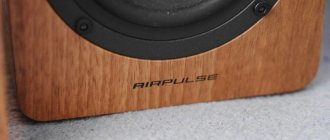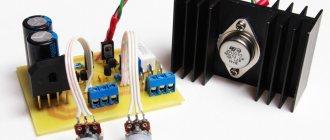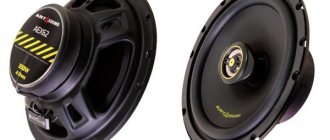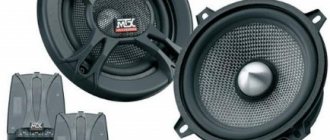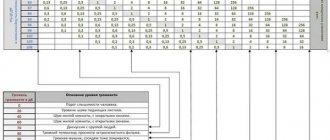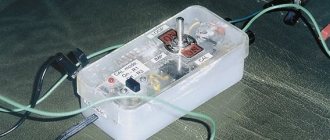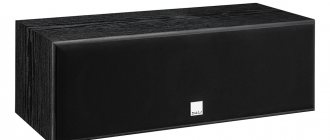What are there
The best manufacturers have filled the market with high-quality car audio equipment. All manufactured goods are classified according to various criteria, based on their purpose, main characteristics, design features, and so on. There are two types of systems:
- Coaxial heads. It is based on a woofer - midrange speaker, above the diffuser of which a tweeter head is installed on a stand or bracket. The device does not take up much free space and allows you to mount the product yourself. However, high sound quality is not available.
Advantages of the system:
- easy and simple to install;
- inexpensive;
- simple and easy to adjust settings;
- high-quality sound even in budget models.
Flaws:
- The playback quality is inferior to component acoustics.
- Professional products, complex and expensive. Separate speakers are responsible for high, mid and low frequencies. They are equipped with passive and active filters or crossovers - devices that separate the audio signal into high-frequency and low-frequency - midrange frequencies. Makes it possible to achieve the highest quality reproduction.
Pros:
- the ability to build an acoustic stage;
- produces clear, loud and spacious sound;
- the best models will be a help during parties and corporate events.
Minuses:
- not everyone will figure out how to install;
- at a significant price;
- difficulty in setting up the sound;
- mistakes should not be made when choosing the installation location;
- the need to use the services of professionals.
Size options
Currently, popular models are produced in three main calibers up to 20 cm:
- 16.5 – 17 centimeters (6.5 – 7 inches);
- 13 centimeters (5.25 inches);
- 10 centimeters (4 inches).
Eight-inch (20-millimeter) speaker systems can also be found on the shelves of domestic stores.
There are other types of standard sizes: 8-inch heads are used in subwoofers, HF heads in component acoustics ranging in size from 1 to 2 inches.
Differences in Shape
Manufacturers produce products of elliptical and round shapes. The latter are used in component acoustics. Ellipticals are mainly used to produce coaxial models.
Diffuser material
The following basic materials are used in the manufacture of resonators:
| View | Description |
| Silk | Present in dome tweeters. To make the material rigid, it is impregnated with special compounds. |
| Kevlar | Exotic option. An analogue of fiberglass, but it is particularly durable and has a significant price. |
| Pressed cardboard or paper | Classics of the genre. The most current material. Reproduces sound with maximum authenticity and quality. Treated with a special impregnation that improves quality and resistance to negative environmental influences. Not afraid of humidity. |
| Aluminum | It has not been widely used due to its high cost. Provides maximum playback quality with minimal distortion. What to look for when choosing? For any deficiencies. According to buyers, an illiterate approach to building speakers in a car will negatively affect the sound quality. |
| Fiberglass | It has an interesting appearance, reasonable cost, and good sound characteristics. |
| Polypropylene | Refers to inexpensive and high-quality materials. Distinctive features are strength and light weight, as well as excellent decorative qualities. It is very popular. |
Which car acoustics are the best?
Car acoustics is a thing that is seriously different from any other area of sound. This is primarily due to the fact that the interior volume is extremely limited, and already has a very noticeable impact on the final result. The very places for installing speakers available in cars can terrify any audiophile: by all standards, it simply cannot sound, and especially the speakers in the doors, because instead of a calculated and correctly configured rear volume, we get a metal box with power windows inside. The choice of materials is also limited: no matter how great non-impregnated (and especially not reinforced) high-end paper speakers sound at home, in a car they will quickly fail due to changes in temperature and humidity.
The simplest version of car speakers is wideband , in which a single diffuser is forced to play the entire frequency range. But this is also the worst option: in order to ensure the processing of high frequencies, the diffuser has to be made light and fragile, and it will noticeably wheeze, deforming, even at a low bass level.
There are two recipes to combat this. The first is coaxial acoustics : one or more additional speakers are attached in the center of the main speaker. By making the main diffuser stronger, we will ensure acceptable lows and mids, and the high frequencies will be played by the central diffuser, which is light and soft. But all parts of the coaxial speaker will play in one direction, and in a car these are primarily the driver’s feet (front acoustics) and the rear window.
In component acoustics, each band of the spectrum is represented by its own speaker in a separate housing. The tweeter here is not limited by the cone of the main diffuser, and during installation it can be directed in the most comfortable way for hearing. The frequency separation itself here occurs not with a primitive filter, as in coaxial acoustics, but with a serious crossover, which will allow you to ideally divide the sound spectrum into those speakers that should process it.
The simplest example of the difference in sound is budget and luxury cars. The former have cheap broadband speakers installed from the factory, and even installing coaxial acoustics in standard places already improves the sound - the “highs” become cleaner, the “lows” become more energetic and powerful. But now compare the sound with the standard component acoustics of a high-end car, where the sound stage can be formed by more than a dozen speakers: you must agree, the difference is colossal. With the help of a set of component acoustics and a competent installer, you can achieve excellent sound in your car, even if it is not a Maybach. The main thing is to make the right choice. So, the winners of the nominations in the ranking of the best car speakers...
Recommendations for choosing the right model
How to choose the best speaker for your car? First, you should conduct a review of the products offered, look at the ratings of quality products and reviews from owners, get acquainted with new products, and listen to the advice of professionals. It's hard to quickly decide which one is better to buy. There are many global manufacturers and each one tries to surpass competitors in the quality and reliability of their products.
Where to buy the selected model? It is best to visit a specialized store where listening stands are installed. The speakers will immediately show what they are capable of. Human needs and musical ear are individual. Therefore, you can listen to recommendations, but the choice is up to the individual user. A live wiretap will help you decide.
The main criteria when choosing a product are as follows:
- Financial capabilities of a person. This indicator affects the range offered. There is no point in equipping a VAZ with equipment that costs 100,000 rubles.
- System type.
- Company manufacturer. Sometimes, even with the same characteristics, you have to pay extra for the brand.
- Suspension. You should choose between fabric and rubber ones. Rubber ones do not allow vibrations if you use the device at its maximum capabilities.
- Presence of tweeters. The need for this arises when there is a desire to equip your own car with unsurpassed acoustics. The best option is silk tweeters.
- Standard size. It is necessary to first take measurements of the seats, and then decide on the device.
- Other features of the radio. Cheap Chinese products cannot be of high quality, since they are equipped with low-quality built-in amplifiers. An expensive product works with various speakers of any type.
- Rated power of the device. You should not pay attention to the peak.
- Sensitivity. The value is measured in dB. The higher the number, the better the sound quality.
- Resonant frequency. Determines the depth of low frequencies. The minimum resonant frequency implies high-quality bass.
- Availability of instructions for use.
- Holes for mounting the product. If they are absent, problems will arise with the installation of the product.
Rating of the best 20 cm speakers for cars for 2022
Coaxial
Mystery MF 83
The best option for those who do not need very high-quality sound. A 20-centimeter device with a nominal rating of 100 W, a frequency range from 35 to 21000 Hz. The diffuser is made from Mylar. The suspension is made of NRB rubber. The basket is stamped.
How much do the products cost? You can purchase it at a price of 3,451 rubles.
Mystery MF 83
Advantages:
- Excellent sound clarity at high volumes;
- good bass;
- reasonable cost;
- versatility;
- durability;
- Uneven sound across channels is at a minimum.
Flaws:
- none.
Mystery MJ 830
The manufacturer has launched the production of three-way coaxial speaker systems at an affordable cost. A distinctive feature is noteworthy characteristics. Standard size – 20 centimeters, power – 40 W, frequency range – 28 – 30000 Hz, sensitivity reaches 87 dB/mW.
Cost: 900 rubles.
Mystery MJ 830
Advantages:
- good and balanced sound;
- high power and sensitivity;
- no HF and MF distortion;
- reasonable cost;
- ease of use;
- durability;
- reliability;
- no wheezing.
Flaws:
- not installed.
Pioneer TS-A 2013 I
The manufacturer produces high-quality and durable eight-inch three-way speakers. Rated power – 80 W, sensitivity – 91 bD, impedance – 4 Ohms. Can be mounted in seats of any cars. Frequency range up to 3000 Hz is suitable for the most demanding user. There are HF, MF and LF speakers. Installation depth – 89 mm. Included in the TOP of inexpensive but high-quality models.
Retailers offer products for 4,920 rubles.
Pioneer TS-A 2013 I
Advantages:
- three frequency bands;
- high-quality manufacturing;
- sound purity;
- cost/quality ratio;
- stylish appearance;
- no distortion at significant power;
- clear instructions;
- ease of installation;
- long service life.
Flaws:
- lacks bass;
- too many high frequencies;
- no protective grille is provided.
Alpine SXE – 2035s
Speakers 20 cm. Three-way speakers. The quality and reliability of the product has been tested by time and numerous users. Rated and maximum powers are 45 and 280 W, respectively. Neodymium magnet. Foam rubber suspension. The outer part is made of cellulose, silk dome on a rotary tweeter. Differs in power. Subwoofer technologies were used in the production of the suspension. Speakers can be installed at the bottom of the doors.
The average cost is 3181 rubles.
Alpine SXE – 2035s
Advantages:
- the power is worthy of respect;
- good bass;
- standard fastenings;
- ease of installation;
- ability to customize the equalizer of the head unit;
- virtually no distortion;
- the ability to order online in an online store;
- positive reviews;
- warranty period – 1 year;
- value for money.
Flaws:
- The quality of mid and high frequencies leaves much to be desired.
Component Models
Eton POW 200.2
The world's leading manufacturer supplies high quality two-component eight-inch speaker systems to the domestic market. It differs from its analogues in its modern design and progressive features. Belongs to the category of innovative systems. Equipped with an attractive branded rubber cap. 25mm aluminum-coated tweeter.
The average cost is 9400 rubles.
Eton POW 200.2
Advantages:
- good sound;
- the power is worthy of respect;
- overload capacity;
- virtually no distortion;
- the ability to order online in an online store;
- positive reviews;
- value for money.
Flaws:
- none.
Focal Integration ISU 200
A reliable and high-quality twenty-centimeter two-way kit falls into the category “suitable for everyone, everywhere.” Truly powerful and compact. The minimum dimensions were achieved by reducing the depth of the housing and the filters built into it. This makes it possible to easily and quickly connect it to the head unit. Innovative technologies were used in production. The tweeters are made of a new inverted aluminum-magnesium alloy, resulting in cleaner and higher frequencies. Maximum power – 160 W, sensitivity – 93 dB, impedance – 4 Ohms.
The product can be purchased for 9460 rubles.
Focal Integration ISU 200
Advantages:
- good and balanced sound;
- high power and sensitivity;
- perfect vocals;
- excellent crossovers;
- no HF and MF distortion;
- reasonable cost;
- ease of use;
- durability;
- reliability;
- absence of wheezing;
- good bass;
- If installed correctly, you might think that the car has a subwoofer installed.
Flaws:
- There may be drops of glue on the speaker basket.
Morel Elate TI 902
Eight-inch component speaker with a rated power of 200 W. Sensitivity 2.83 V/m, frequency range – 25 – 25000 Hz, standard impedance – 4 Ohms. There are two bands, an external crossover, high-frequency and low-frequency speakers. The design is rotating.
The average cost is 45,561 rubles.
Morel Elate TI 902
Advantages:
- excellent sound;
- practicality;
- functionality;
- versatility;
- reliability;
- long service life.
Flaws:
- none.
Case products
Mystery MJ 105 BX
The company has set itself the goal of equipping the market with inexpensive but high-quality equipment. The three-way case model AC MJ 105 BX is a device with acceptable characteristics at an affordable price. The frequency range will not delight music lovers, but the sound panorama is acceptable. The high-quality ABS plastic case is made in black, so it looks stylish. The convenience of the connectors makes it possible to spend a maximum of 10 minutes on installation.
The average cost is 1310 rubles.
Mystery MJ 105 BX
Advantages:
- “ridiculous” price;
- high sensitivity;
- simplicity of installation;
- compactness;
- ease of use;
- reliability.
Flaws:
- The installation depth of low frequencies leaves much to be desired.
Boss BRRF 40
A two-way speaker with Bluetooth and LED backlighting will appeal to many connoisseurs of convenience and quality. Maximum power – 1000 W. The design is classified as moisture resistant.
The product is sold at a price of 44,000 rubles.
Boss BRRF 40
Advantages:
- high-quality case;
- significant power;
- excellent sound;
- The manufacturer provides a 1 year warranty.
Flaws:
- overcharge.
Boss ATV 85 B
A good purchase for those who want to listen to high-quality music on long trips. The construction material is moisture-resistant, which significantly extends the service life of the product. There is Bluetooth and a 3.5 mm input.
The average cost is 21,500 rubles.
Boss ATV 85 B
Advantages:
- build quality;
- durability;
- positive reviews;
- the possibility of purchasing both at a specialized retail outlet and in an online store;
- reliability;
- practicality;
- ease of use.
Flaws:
- not identified.
Rockford Fosgate PM 282 W–B
The two-way 20-centimeter device is reliable and durable. Significant power of 100 W allows you to listen to music on roads with the worst surfaces. Suitable for installation on a yacht or boat. Not afraid of aggressive environments. The significant dimensions of the loudspeaker make it possible to enjoy your favorite melody in an open space, while the sound quality does not deteriorate.
The sellers are asking 45,000 rubles for the products.
Rockford Fosgate PM 282 W–B
Advantages:
- functionality;
- versatility;
- practicality;
- modern design;
- excellent sound.
Flaws:
- not found.
Subwoofers
JBL Stage 800BA
The active device is made of MDF and painted black. Designed for music lovers. There is a built-in sound amplifier. The rated power of the woofer is 100 W. Frequency range – from 30 to 200 Hz. The main feature is that it is equipped with an speaker cable for connecting to an audio system. The design is simple and functional. The presence of protective arches helps prevent mechanical damage to equipment and protects against impacts. The rear panel has a rotary audio control knob. Built-in Class D amplifier.
The product can be purchased at a price of 7,799 rubles.
JBL Stage 800BA
Advantages:
- high-quality sound;
- convenient operation;
- practicality;
- reliability;
- long service life;
- minimal energy consumption;
- does not heat up;
- equipped with a wired control panel;
- the presence of massive protective panels;
- convenient volume adjustment;
- undergoes rigorous testing;
- certified product;
- not afraid of ultraviolet radiation and high temperatures;
- affordable price;
- compactness.
Flaws:
- not installed.
Eton B 195 Neo
Single-band devices with a power of 150 W and a sensitivity of 88 dB. One 20-centimeter speaker with neodymium magnet. The manufacturer produces products for installation in BMW cars.
The average price is 14,250 rubles.
Eton B 195 Neo
Advantages:
- durability;
- functionality;
- practicality;
- value for money;
- build quality.
Flaws:
- limited scope of use.
JL Audio CP 208 LG – W 3 v 3
The company has launched the production of high-quality and reliable audio equipment for prestigious cars. An eight-inch device with a rated power of 500 W, impedance - 2 Ohms. Equipped with a bass reflex housing with dimensions 90.2 * 27.9 * 13 cm, two speakers.
The average cost is 69,800 rubles.
JL Audio CP 208 LG – W 3 v 3
Advantages:
- qualitative;
- reliable;
- will delight music lovers;
- the sound is worthy of respect;
- not afraid of mechanical damage;
- long service life.
Flaws:
- lack of built-in amplifier;
- expensive.
Alpine SBG – 844 BR
Considered a good purchase. For little money you can become the owner of a high-quality and practical product. The power is not significant, but sufficient for listening to any music. The bass reflex housing has dimensions: 275*283*325 mm. There is no built-in amplifier.
The average cost is 5370 rubles.
Alpine SBG – 844 BR
Advantages:
- does not take up much free space in the trunk;
- the bass is worthy of attention;
- pure play;
- no distortion;
- adequate cost;
- versatility;
- functionality;
- ease of use;
- ease of installation.
Flaws:
- not identified.
Hertz DBA 200.3
The eight-inch single-way subwoofer will appeal to lovers of calm melodies. Equipped with a case with a passive radiator and a built-in amplifier. Impedance – 4 Ohms. There is one woofer - speaker. The diffuser is made of water-repellent paper. Minimum service life is 2 years.
The average cost is 17,000 rubles.
Hertz DBA 200.3
Advantages:
- additional equipment – two passive radiators;
- warranty – 1 year;
- compactness;
- excellent power;
- clear sound;
- reliability;
- quality lows;
- excellent bass;
- no lag or hum;
- built-in amplifier;
- pressure;
- intelligent inclusion;
- adjusting settings.
Flaws:
- It’s inconvenient to connect power;
- must be installed in the trunk strictly in the middle;
- overpriced.
Midrange speakers
Ural AS – PT 200 Patriot Black Edition
Single-way mid-frequency speakers for cars are a budget option. Has a limited range of actions. Size – 8 inches, power – 180 W, sensitivity – 99 dB, impedance – 4 Ohms. Installation hole – 17.8 cm, installation depth – 9.1 cm.
The average price is 1850 rubles.
Ural AS – PT 200 Patriot Black Edition
Advantages:
- acceptable price-quality ratio;
- ease of use;
- practicality;
- easy to install;
- reliability.
Flaws:
- not installed.
Pride W 8 inches
The manufacturer pays attention to the quality of its products with significant power (300 W). A reliable and practical device at an affordable price has appeared on store shelves. There are no complaints from users.
The average price is 8450 rubles.
Pride W 8 inches
Advantages:
- convenient dimensions;
- easy to install;
- no significant restrictions;
- sound clarity is excellent;
- long service life.
Flaws:
- none.
Pride Solo 8
Mid-range eight-inch single-way speaker. Reproduces frequencies in the range from 125 to 8000 Hz, impedance – 3.2 Ohms, sensitivity – 97 W/m. Cellulose resonator. Users note good sound quality and ease of use.
The average price is 10,000 rubles.
Pride Solo 8
Advantages:
- easy to install;
- compact;
- durable;
- reliable;
- a good purchase.
Flaws:
- the price is a bit steep.
Edge Edpro 8 B – E 7
Single-band mid-frequency device belonging to the budget class. Midrange size – dynamics – 20 cm. The membrane is made of high-quality pressed cellulose. Equipped with a ferrite magnet. Frequency range – 150 – 10000 Hz, impedance – 4 Ohms.
The product can be purchased at specialized retail outlets at a price of 2,000 rubles.
Edge Edpro 8 B – E 7
Advantages:
- optimal combination of price and quality;
- reliability;
- ease of installation and use;
- build quality;
- acceptable sound;
- long service life;
- not afraid of environmental influences.
Flaws:
- none.
Broadband models
Avatar BBR – 80
A twenty-centimeter single-way speaker with a rated power of 50 W and a sensitivity of 91 Hz. The resonator is made of paper with a moisture-resistant coating. The range of uses is wide. Suitable for any class of car. Despite the “ridiculous” price (1990 rubles per unit), users have no complaints about the quality of the product.
Avatar BBR – 80
Advantages:
- easy and quick to install;
- easy to use;
- versatility;
- functionality;
- durability.
Flaws:
- not found.
Swat Pro GR – 88
The system is of the broadband type. It has the following indicators: impedance – 8 Ohms, sensitivity – 98 dB, power – 180 W. Suitable for cars of any brand. The owners of the device have no complaints about the purchase.
The average price is 2645 rubles.
Swat Pro GR – 88
Advantages:
- simple assembly;
- ease of use;
- warranty period – one year;
- versatility;
- reliability;
- small dimensions.
Flaws:
- not identified.
Ural AS – M 200 Molot
The wideband eight-inch speaker system is very popular among car enthusiasts due to its quality and ease of use. There is one band, sensitivity reaches 94 dB, installation hole - 185 mm, installation depth - 72 mm. Guaranteed service life - 2 years without breakdowns.
The average cost is 2022 rubles.
Ural AS – M 200 Molot
Advantages:
- The optimum ratio of price and quality;
- easy to install;
- convenient to use;
- reproduces sound quality;
- reliability;
- durability;
- positive reviews;
- functionality;
- versatility.
Flaws:
- none.
Setting up car audio
So we either have a system that has existed for a long time or a newly installed one. And we really want to set it up. Here we will consider the most complex of ordinary everyday systems, namely: front + rear + sub and everything from amplifiers.
To set up a simpler system, simply skip the items that do not apply to you. To make it easier to work with, the tracks from the test disc are in MP3 format and are of good quality, but they don’t pretend to be mega-super quality.
I think we need to start with a big digression from the topic. I want to tell you why your speakers are burning. Roughly speaking, speakers can burn out from two phenomena.
I often hear stories like this: “I bought dead pancakes, connected them to a mafon, pumped them all the way, and they burned to hell. Only the bass player drones now. The pancakes were really crap...” And after this incident it is absolutely impossible to convince a person that his radio is producing no more than 15-18W and the pancakes were at least 25W. It is not surprising that THIS is the essence of the problem.
Chart No. 1
Shows the low frequency sine supplied to the amplifier. As you can see, in normal mode the signal for the tweeters is almost zero (purple zone).
In a conventional multi-way system, the tweeters have much less power than the woofer. This is why, say, at 20W, the power of the tweeter will be about 1-2 watts and it will be enough for the eyes. The bass frequency signal is cut off from the tweeter by a crossover and it does not respond to it at all. Where there are no tall tweeters, the squeaker is silent. Such a pleasant picture will be observed until we overload the amplifier. After this, the picture will change according to schedule 2.
Due to its operating characteristics, when an amplifier is overloaded, it begins to emit high-power distortions called harmonics into the high-frequency range. And the more the system is overloaded, the more power these distortions will achieve. Since they will have fairly high frequencies, the crossover will pass them to the tweeter with a clear conscience.
A two-pronged tweeter naturally cannot withstand the horsepower of 10-12 watts and will instantly burst into flames. It is not designed for such power. As a result, due to the crooked hands of the owner, the dead radio tape recorder acquires the status of mega-powerful, and the pancakes become “shitty”. I also want to note that in conditions of poor power supply to the radio, the amplifier will distort distortion much earlier and the pancakes will burn at a much lower volume than with good power supply.
The most dangerous and unpleasant phenomenon in car audio after a short circuit is the CLIP of the amplifier at low frequencies. Any power amplifier has a power supply and, roughly speaking, the maximum power delivered by the amplifier will ultimately be limited by the capabilities of the power supply. While the amplifier is operating in normal mode, the simplest sound signal will have the following form:
That is, simply put, the speaker will move in one direction until the power reaches its maximum, then immediately return and move in the other direction by exactly the same amount. In this case, you can notice that the maximum power will be supplied to the speaker only for a very short time and during the entire signal the speaker will move, cooling the coil and doing maximum work. Its efficiency will be maximum and heating will be minimal.
Now we overload the amplifier a little, the amplitude of the amplifier is already slightly greater than the capabilities of the power supply and we have this graph.
Since the power cannot be greater than what is in the supply, the signal will stop growing and stop at the maximum until the signal begins to decline. This is called signal modulation.
What happens to the sub? The sub, reaching the limit of the maximum amplitude of the signal, “freezes” in extreme positions until the signal begins to decline and moves to the next extreme position where it freezes again. During moments of freezing, the maximum voltage is applied to the speaker coil, and since the speaker hangs without cooling and without doing any work, all the energy is spent on pointless heating of the coil and magnetic system.
When the speaker operates this way, at best, we lose the efficiency of the speaker. The bass sound becomes flatter and less expressive; in addition, due to heating, the resistance of the coil increases and after a couple of songs the speaker begins to play quieter. As a rule, this entails the third schedule and the most unpleasant option. We make it louder by driving it into a hard clip. At this moment the pancakes, as a rule, still have some reserve and begin to play a little louder and it seems to us that it has become louder, but the sub did not begin to play louder - it began to FRY!
Here is chart #3 hard clip:
In this mode, the speaker takes off sharply and freezes for most of the signal time, then abruptly changes position and freezes again, while the amplifier mercilessly fries the speaker coil. As a rule, after a short time (from a minute to 4-5 minutes, depending on the survivability of the speaker and the difference in power), the speaker coil burns out, throwing off the vids, annealing the supply lines, and foaming the varnish. The speaker becomes completely unusable and requires complex repairs.
The most dangerous thing about a clip is that, firstly, it is quite difficult to catch it with inexperienced ears, and secondly, it is quite REALLY possible to burn a sub with an amplifier clip that is THREE times more powerful than the amplifier, which at first glance seems unrealistic.
To summarize the above, we can say: speakers in 95% of cases burn due to LACK of power and crooked hands.
As for subs, they rarely burn out due to excess power. They tear, break coils, break diffusers, yes, but they don’t burn. And then until the sub breaks, it will be hellishly wheezing and crackling, it’s impossible not to hear this.
It is this property that many ES engineers skillfully take advantage of, placing the speakers in conditions that are comfortable for movement and briefly supplying DOUBLE the unclipped power allowed to the speaker.
Knowing about these harmful phenomena, we will begin setting up the system.
Download the archive with the tracks from here.
Before you start setting up, you should check that the speakers are connected correctly to the amplifiers and radio. All speaker pins are marked with + and - polarity. The speakers also have this marking. But by running the wires to the radio, you can reverse the polarity. Nothing fatal will happen. Everyone will start singing. but the speakers at low frequencies will begin to jump in different ways: one forward and the other backward, pumping air into each other, dropping the low frequencies. is that bad.
To avoid this, take any 1.5 volt battery and attach it to the wires to each speaker in turn. If the speaker moves forward, the polarity is correct. If the speaker has moved back, we mark it the other way around.
Now, in accordance with our markings, we connect the speakers to the radio. We charge the battery, turn off the car, turn off all kinds of bass boosts, sound enhancers, etc. in the radio, set the equalizers to 0 and turn on the tracks:
If your system is not new and has already worked. then for comparison you can listen to all the tracks from the “test tracks” folder before and after tuning. Well, compare the results.
Track No. 1, 2, 3 from the root of the archive. Using them we determine the correct connection of the speakers at low mid and high frequencies. When the voice sounds in phase, the sound should be collected in the center of the cabin or in front of you and you should clearly hear that it sounds in the middle. When a voice sounds out of phase, the sound should scatter throughout the cabin and sound to the left and right separately. If everything turns out the other way around, it means the polarity of one of the speakers is reversed.
The brightest effect should be heard at low frequencies. At medium levels this is no longer the case, but at high levels the difference between the phases is often not audible at all. This is basically normal.
So, turn off the sub and rear speakers. We play the track at medium volume only on the front ones, correcting the polarity if necessary.
Then we separately run the rear speakers in the same way. Then all 4 speakers. In this case, you can try to reverse the polarity of both rear speakers, sometimes after this the sound of the tracks becomes even more focused.
After that, turn on the sub and listen to tracks with it. Then we change the polarity of the subwoofer connection and listen again. Let's leave it the way we liked it best. We figured out the most important thing.
Let's determine the capabilities of the front and rear speakers. Turn off the subwoofer and set the speaker volume control (GAIN) to the middle position. We switch the crossovers of the amplifier (or radio, if there is no amplifier) to full mode. We make the sound volume low and launch tracks from the “sines” folder, listen to tracks from 20Hz and higher. At first there will be practically no sound, but at a certain frequency the hum will begin to appear and will increase sharply with increasing frequency. We remember the frequency of the track on which the speakers are already buzzing confidently and are clearly audible. We switch the amplifier's crossover to HPF mode and, using the controls on the amplifier, set approximately the frequency that we remembered on the track. If you have a 4-channel amplifier for the main speakers, then the test must be carried out separately for the front and rear speakers and the filters for each pair of channels must be set accordingly.
Next, let's determine the volume of the main speakers. Turn off the sub, set the amplifier volume control to minimum and play the “5 metal” track from the “test tracks” folder. We turn up the volume on the radio until we hear distortion in the speakers, turn it down 2-3 points and start turning up the volume control on the amplifier. We increase it until distortion appears, then turn it down a little. This is the maximum volume of our main speakers (with a 4-channel amplifier, we adjust separately for the front and rear speakers. If the speakers are connected to the radio, then by adjusting the fader in the radio, we ensure that all speakers begin to distort the sound at the same time.
Now you need to decide on the maximum capabilities of the subwoofer.
If the sub is in FI design, then you first need to install a subsonic cutoff or an infra-low-pass filter. We set the volume of the sub amp and a small radio to medium, turn on the sines and look at the sub. As the sine frequency increases, the stroke of the speaker will decrease and the volume will increase. As soon as the volume becomes maximum and the stroke is minimal, this is the phasic setting, look at the frequency of the track and set the subsonic cutoff according to it. If this is not done, there is a risk of breaking the sub sooner or later. This point should be skipped by those who have a sub in the registration of the land plot.
After that, turn off all the speakers so as not to interfere and leave only the subwoofer. We switch the crossover on the subwoofer amplifier to LPF (low-pass filter) mode and set its cutoff as high as possible, for example, 100 hertz. The volume control (GAIN) MUST be set to minimum. From the “test tracks” folder, launch the track “1 sub”. This is the familiar anthem of the bass club. The bass in it is very loud and pumps at everyday frequencies, which is what we need. First, we turn the volume of the radio until we hear in the subwoofer that the signal begins to change and distort. As soon as we hear distortion, we turn the volume down 2-3 points and begin to slowly increase the volume level on the sub amplifier, while listening to how the sub increases the volume. As soon as we heard that the sound began to change, or stopped increasing the volume, we move the gain back a little and leave it like that. This is the Sub's Safe Limit. If it is possible to feel the magnet of the speaker, then you can drive this track by feeling the heating of the magnet; if there is no noticeable heating and your hand tolerates it, then the setting is done correctly. This adjustment can be carried out after replacing the supply wires or amplifier.
After that, turn on the sub and speakers. On the sub amplifier, to begin with, in setting the LPF filter, we set the frequency that we cut off when tuning the main speakers with sines. We start the sines again and listen one by one. Especially at frequencies where we made a cutoff boundary. If during the transition of frequencies from the subwoofer to the main speaker you can noticeably hear a decrease in volume, then you need to turn the gain control of the subamplifier a little quieter and listen again until the volume differs so much. If, when switching frequencies, you hear a sharp increase in sound volume, then you need to make the cutoff of the sub amplifier filter lower until the sound levels out by ear.
We are done with the basic sound settings. Let's move on to something more personal:
At medium volume, play the songs from the “test tracks” folder one by one and listen.
On the track “2. drums" you can evaluate the performance of the main speakers. Adjust the equalizer in the radio so that the sound is not droning, intrusive, or persistent. Was as clear and pleasant as possible. Similarly, we listen to the tracks “3.medium” and “4.tweeters.” On the last track, you can also adjust the reflection of the beepers from the glass or the angle of inclination directly, so that the beepers do not “hit the ears” but are not intrusive and clear.
Well, the last stage: play all the tracks from the “test tracks” folder at different volumes, assessing the sound and little by little adjusting everything individually to your ears. At the same time, you should be careful about increasing the volume of the amplifiers too much so as not to burn everything to hell).
Well, that's all. Enjoy! It remains to mention that with a running car and good nutrition, as a rule, you can make it one unit louder than with a switched off car, and blacks should be listened to 2-3 points quieter than all other music.
